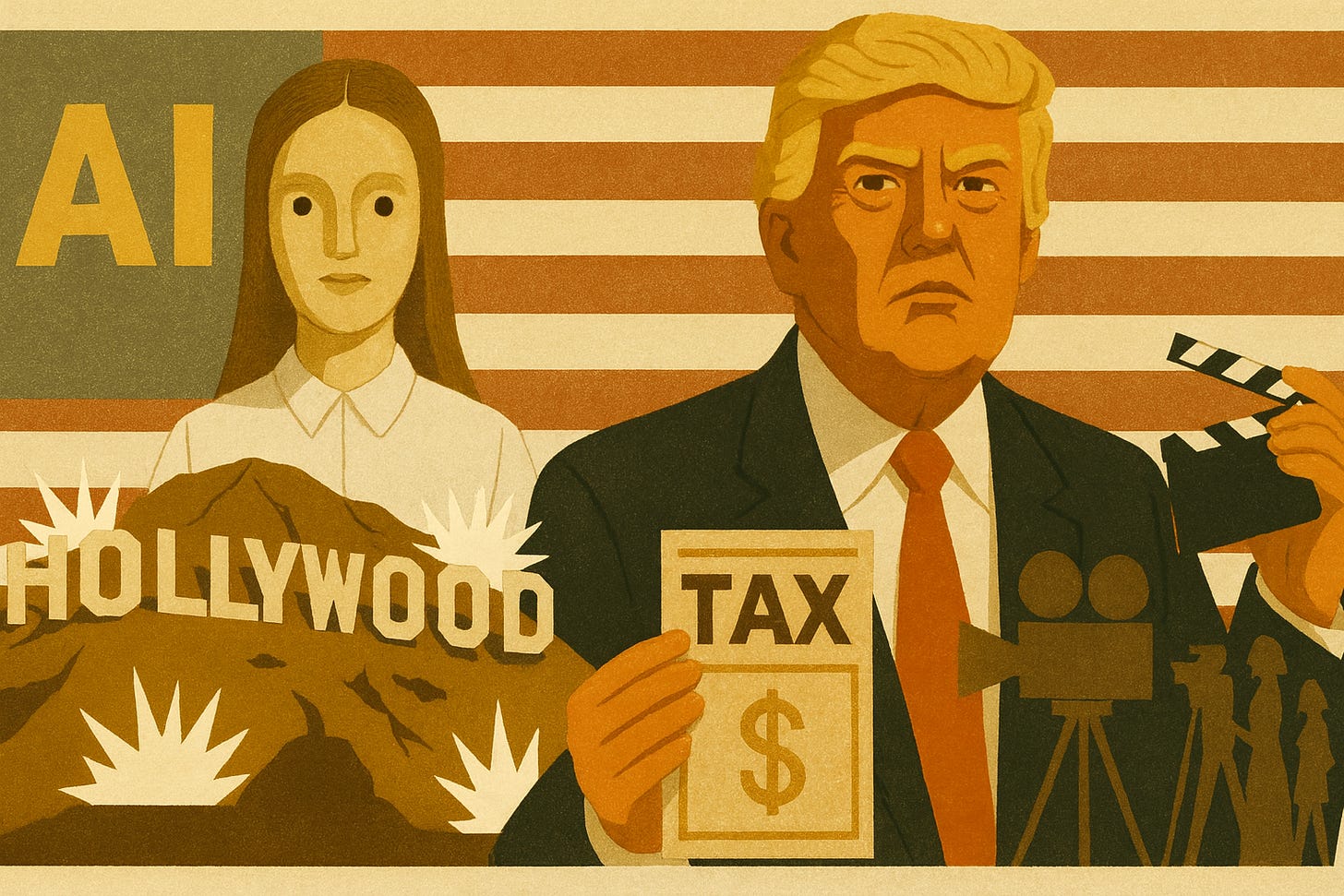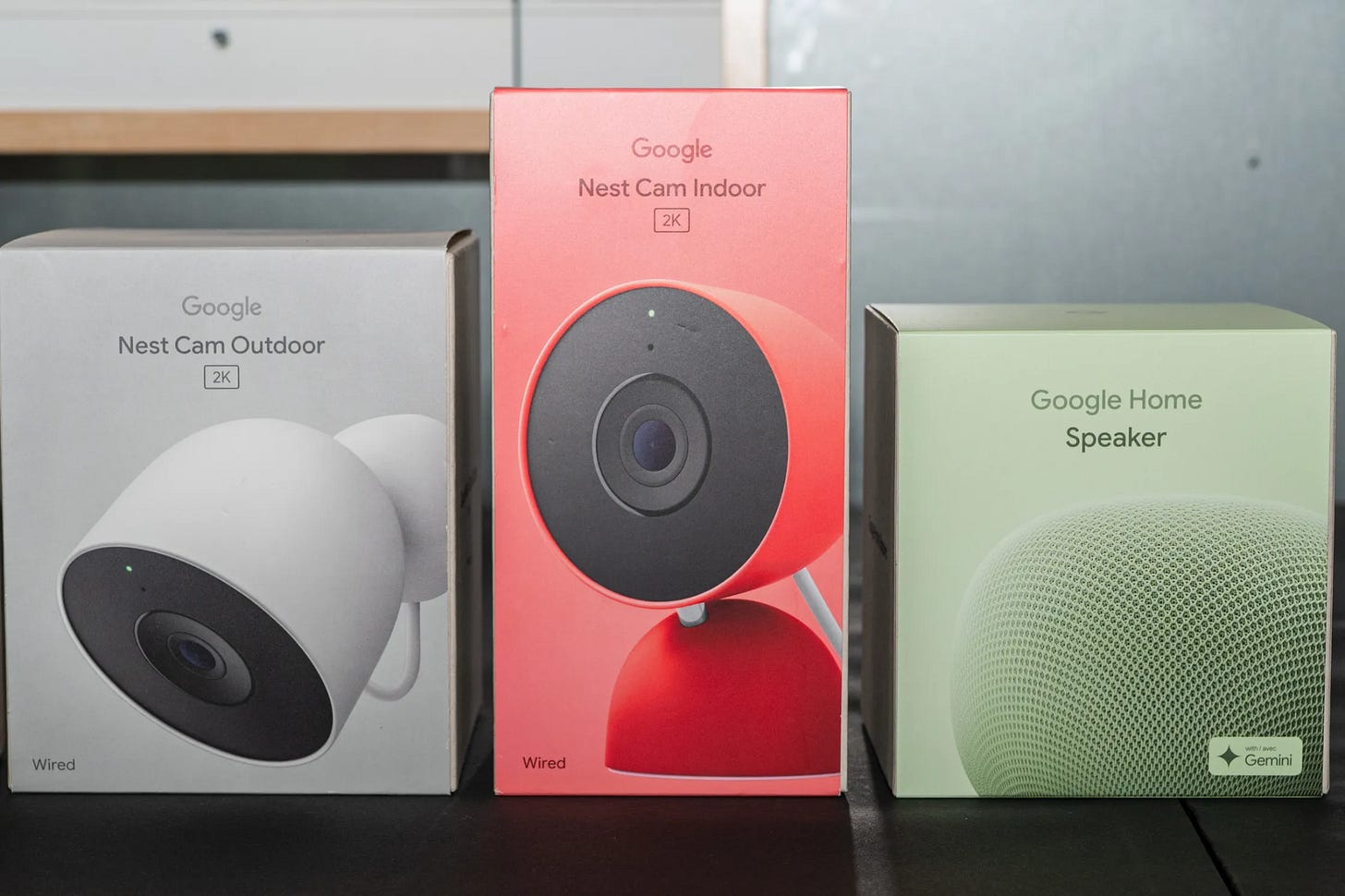Tariffs, Titans, and Tilly: America’s New Film Fight
Trump declares war on foreign production, Sag-Aftra wars digital actresses, and a creative class on the brink.
Hi Everyone —
It’s launch day at Eddie, your AI AE (uh hem… assistant editor ☺️).
Eddie now… <drum roll> provides feedback on your edit. And it’s pretty cool. (And that’s me trying to temper expectations.)
Okay I give up. It’s actually kinda insane.
Eddie AI can now analyze your edit in both the audio/visual mediums and give you detailed timestamped feedback intended to improve performance of the edit, such as for YouTube / online distribution.
Try it by updating to the latest Eddie AI Mac/PC app. Click “New Project” and choose “Feedback” mode. Then import the mp4/mov of your edit or pull the sequence in from Premiere/Resolve/FCP. Let it analyze and boom. FYI It’s free. (Not sure if we’ll ever charge for it.)
We’ll be demoing this (and other ways to use Eddie for those editing for YouTube) at VidSummit in Dallas on Oct 8 and Oct 9:
Oct 8, 3:35pm, Workshop Room 2
Oct 9, 1:45pm, Workshop Room 2
DM me if you’ll be there.
The other big update is Rough Cut mode now incorporates Social Media, ChatGPT and A-roll logging modes. This means: you just import your source videos once and you can chat to Eddie about key characters and the emotional tone of the story; get your interviews logged; experiment with different rough cut versions of varying lengths; and get a bunch of social clips with titles/descriptions. All from the same import. No need to import afresh for each edit.
I know it was annoying as *&%^. It’s fixed. Have fun with Eddie, play with it, make cool sh*t. You can thank me later.
Here’s the launch video. Robbie is back, safe, if you were wondering. Though I may maroon him again for giving me this click-baity thumbnail.

And finally, we (finally) updated our landing page. Check it out, let me know what you think.
Enjoy today’s newsletter on the news from the world of video.
—Shamir
Trump’s talk of a 100% film tariff has producers doing currency math in their sleep, while the L.A. Times paints a grim portrait of Hollywood’s missing middle. 42,000 jobs gone and counting.
At the same time, SAG-AFTRA has gone full firewall on AI after a digital actress tried to land real representation. Meanwhile in platform land, ESPN and Fox finally fuse into one mega sports bundle, Meta and Apple keep jousting over who owns your face.
Over in AI video, OpenAI’s Sora 2, Elon’s Grok Imagine, and Runway Gen-4 all push closer to photoreal “world simulators.” And if that’s too heavy, DJI’s new Nano and Curio’s talking plush toy prove gadgets are still fun even when the rest of the industry feels existential.
Our visual future remains in the balance.
Headlines at a Glance
ESPN + Fox One Streaming Bundle Finally Launches: Another mega-sports package crowds the OTT shelf; UI fragmentation vs. ARPU uplift becomes the fall debate for streamers.
Taylor Swift’s ‘Release Party of a Showgirl’ Powers Box Office: A pop event film outmuscles traditional releases, underscoring the rise of fan-first theatrical windows.
‘Kill Bill: The Whole Bloody Affair’ Gets First Theatrical Run : Tarantino’s unified cut hits 70mm/35mm in December; repertory programming continues to punch above its weight.
One Battle After Another’ Tops $100M, will it break even? Dicaprio and PTA might not be enough to see “film of year” action thriller over the line.
UK film industry dubbed “Brollywood” seeing a boomL for now: The U.K. is attracting major shoots, thanks to tax incentives and infrastructure, but faces uncertainty if U.S. policies (like the proposed tariff) disrupt that momentum.
Cinema’s Next Trade War: Trump Tariff
Donald Trump’s latest tariff threat has Hollywood sweating and not just from the L.A. heat.
At a rally last week, the president floated a 100% import tariff on foreign-made films, a move that would effectively double the cost of any movie shot outside U.S. borders. The proposal has sent shockwaves through production hubs from Vancouver to Budapest, where Hollywood has outsourced everything from blockbusters to prestige TV for decades.
According to The Hollywood Reporter, producers are already running the math.
Entire budgets could implode overnight, particularly for streamers and studios reliant on tax incentives abroad.
The policy, if enacted, could force an industry repatriation. Pushing shoots back to California, Georgia, and New Mexico, where costs are higher and crew capacity already stretched.
Post-production vendors in Canada, the U.K., and Australia are equally on edge, as their Hollywood pipelines could dry up.
What’s most striking is how out of sync this potential ruling feels with the reality of modern filmmaking.
Hollywood today is a global organism. Camera teams in Prague, VFX artists in Mumbai, editors in London. The tariff is essentially a tax on the collaborative DNA of the industry itself.
For now, the proposal is still just talk. But in an ecosystem already navigating strikes, AI anxiety, and shrinking margins, the idea of a cinematic trade war might be one plot twist the industry didn’t see coming.
Hollywood’s Creative Middle Class Is Vanishing
In just two years, Los Angeles’ motion picture workforce has collapsed from 142,000 to 100,000.
That’s 42,000 jobs gone, editors, animators, camera operators, gaffers, line producers, and sound mixers who once moved from show to show without missing a paycheck.
We were hopeful for an industry resurgence after the dual writers’ and actors’ strikes ended in 2023 but that’s become far from the case.
The era of growth at all costs for streaming ended, and profitability became the only metric that mattered.
The result: nearly 30% fewer films and TV series with budgets over $40 million started production in 2024 compared to 2022.
The first three quarters of 2025 aren’t looking good either without production down another 13%.
Production activity in the Los Angeles area has fallen to its lowest level since the mid-1990s, according to FilmLA. For the first time in decades, established crew members are going a year or more without work.
The collapse of mid-budget storytelling has rippled through every layer of the ecosystem. Catering companies, prop houses, costume suppliers, and post facilities are all reporting double-digit revenue drops.
South California, a region once powered by the entertainment economy now has an unemployment rate of 5.7%, well above the national average.
The middle tier that made Hollywood function is being hollowed out. Some have retrained in other fields whilst others have left the state entirely.
For decades, Los Angeles thrived on the belief that there would always be another gig. That belief is wavering now and whether the city’s creative engine roars back to life remains to be seen.
More platform news
Government Shutdown Snafu Keeps Jafar Panahi From NYFF: Real-world politics collide with festival logistics; the premiere goes on without the director.
Paramount Taps Josh Silverman to Supercharge Consumer & Experiential Licensing, products and IRL activations become a bigger P&L lever as film/TV margins tighten.
Fujifilm X-T30 III leaks ahead of October launch: Rumored to share the sensor / processor of the X-S20, possibly with IBIS, offering a more compact and affordable entry into Fujifilm’s X line.
Metahelios pushes next-gen color filter tech for camera chips: A behind-the-scenes semiconductor innovation that could influence future sensor / imaging pipelines.
SAG-AFTRA Draws Line in the Silicon: The Battle Over AI Actors
Last week we touched on Tilly Norwood, the hyper-real digital actress unveiled by Dutch creator Eline Van der Velden at the Zurich Film Festival. This week, SAG-AFTRA officially entered the chat and they’re not handing out welcome baskets.
The union’s message was blunt: “Creativity is, and should remain, human-centered.”
Norwood’s debut was meant to introduce Xicoia, what Van der Velden called “the world’s first artificial intelligence talent studio.” Instead, it ignited an industry-wide backlash. News that Tilly was in talks to sign with a real Hollywood talent agency was seen as crossing a moral and professional line.
SAG-AFTRA’s statement didn’t mince words: “‘Tilly Norwood’ is not an actor,” they wrote. “It’s a character generated by a computer program trained on the work of countless professional performers without permission or compensation.”
The union also reminded producers that deploying “synthetic performers” without notice or negotiation violates contracts, and accused studios of trying to “solve no problem” while creating a much bigger one: the erosion of human artistry and livelihoods.
Actors including Emily Blunt, Toni Collette, Mara Wilson, Lukas Gage, and Nicholas Alexander Chavez quickly chimed in, backing the union’s stance (and maybe hoping not to get out-performed by a cloud subscription)
Van der Velden, for her part, insists the whole thing’s been blown out of proportion. “I see AI not as a replacement for people, but as a new tool — a new paintbrush,” she wrote on Instagram. “Creating Tilly has been an act of imagination and craftsmanship, not unlike drawing a character or shaping a performance.”
The controversy underscores how fragile the peace is between Hollywood and AI post-2023 strikes, when digital likeness protections are becoming the hill everyone was willing to die on.
Whether Tilly ends up as the future of acting or a very expensive cautionary tale remains, fittingly, in development.
Cut of the Week: $3 Trillion War for Mobile’s Future
Casey Neistat is back.
After two months off YouTube, he’s returned with $3 Trillion War for Mobile’s Future, a cinematic tech essay that feels a timeline of our relationship with screens, and a question about what comes after the smartphone.
The video opens with a reminder: Google Glass dropped eleven years ago.
Then Casey traces the lineage, from early mobile bricks to the iPhone era to where we are now: caught between Apple’s $3.7 trillion headset dreams and Meta’s Ray-Ban smart glasses. Both want to build the next interface of human life, but neither has quite cracked it.
And that’s what makes the video compelling.
Casey argues the real X-factor in wearable tech is really etiquette. He recalls being told by his wife not to wear the Vision Pro around their kids: “It just feels rude.”
The future of wearables won’t be decided by their tech. It’ll be decided by what feels socially acceptable to wear.
AI Video News:
OpenAI launches Sora 2 with cameo / likeness features: The new version adds synchronized audio and lets users insert their own face & voice into AI-generated scenes.
Perplexity acquires Visual Electric to compete with Sora / Nano Banana
The acquisition signals that non-big-tech players are taking stakes in the AI video space, expanding into image + video generation to rival OpenAI / Google.
Elon Musk teases Grok Imagine v0.9
Musk claims the latest iteration can generate video (plus text + image) extremely fast, with improvements in realism and performance.
SANA-Video: new diffusion model for efficient, longer video generation
In the academic space, SANA-Video (just announced) allows more efficient generation of minute-long, high-resolution videos using block linear diffusion and constant memory architectures.
Retail Therapy
Nikon drops its first cinema camera: the ZR - $2199.95 SRP (body)
Nikon, under its recent acquisition of RED, has announced the Nikon ZR. A full-frame cinema camera co-developed with RED. It supports internal R3D NE codec, 6K/60p, and 4K/120p.
Google Smart New Nest Cameras and a Smart Speaker
Google’s smart home relaunch feels like a full-system reboot as Gemini replaces Assistant with the hardware getting sharper. It’s less about shiny new gadgets and more about a unified ecosystem with a quiet, confident bid to make your home the next AI interface.
Here are the product prices mentioned:
Google Home Speaker — $100
Nest Cam Indoor 2K — $100
Nest Cam Outdoor 2K — $150
Nest Doorbell 2K — $180
Nest Cam Outdoor 2-pack — $250
If you’re reading in the app, tap the little ❤️ so we know you’re out there.”



